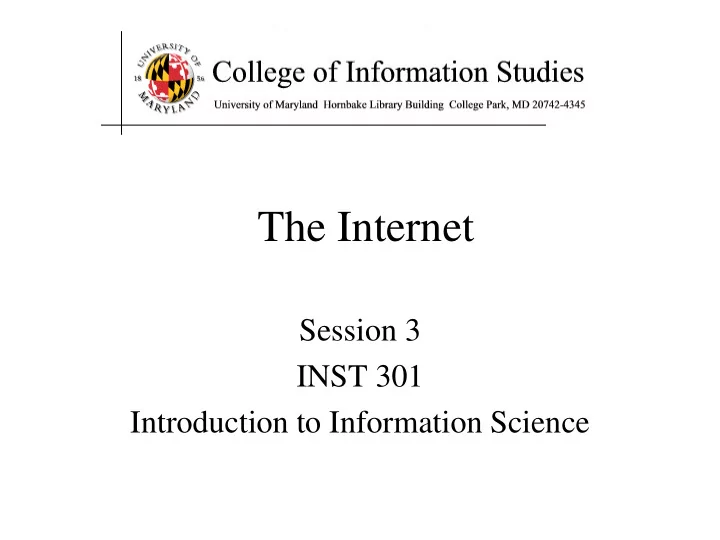

The Internet Session 3 INST 301 Introduction to Information Science
Outline The creation story • What it is • Exploring it • Using it
Outline • The creation story What it is • Exploring it • Using it
Source: Wikipedia
Central Processing Unit (CPU)
Random Access Memory (RAM) Source: Wikipedia
Hard Drive (“Disk”) Extracted From Shelly Cashman Vermatt’s Discovering Computers 2004
Networks of Networks • Local Area Networks (LAN) – Connections within a room, or perhaps a building • Wide Area Networks (WAN) – Provide connections between LANs • Internet – Collection of WANs across multiple organizations
Ethernet Local Area Network (LAN) • All attach to the same cable • Transmit anytime – Collision detection – Automatic retransmission • Inexpensive and flexible – Easy to add new machines – Robust to computer failure • Inefficient – Half the bandwidth is wasted
Switched (“Star”) Network • All attach directly to a hub – Switched Ethernet – Digital Subscriber Lines (DSL) • Higher cost – Line from hub to each machine – Hub must handle every packet • Much higher bandwidth – No sharing, no collisions
Wireless Networks • WiFi is available in several (“maximum”) speeds – IEEE 802.11b: 10Mb/s – IEEE 802.11g: 54Mb/s (required for video) – IEEE 802.11n: 248Mb/s – IEEE 802.11ac: 7 Gb/s • “Wireless Data” plans typical speeds: – 3G: At least 200 kb/s – 4G: At least 100 Mb/sec (required for video) • Bluetooth for peer-to-peer short range – At least 24 kb/s; max range is about 30 feet
An Internet Protocol (IP) Address Identifies a LAN 54.84.241.99 Identifies a specific device
“Leasing” an IP Address Dynamic Host Configuration Protocol (DHCP)
Routing Tables IP Prefix Next Router Estimated Delay 216.141.xxx.xxx 120.0.0.0 18 ms 216.xxx.xxx.xxx 121.0.0.0 34 ms 101.42.224.xxx 120.0.0.0 21 ms xxx.xxx.xxx.xxx 121.0.0.0 250 ms 120.0.0.0 45.0.2.10 121.0.0.0 Mac: netstat -nr Windows: route print
Wide Area Networks • Two key ideas: – Unshared “point-to-point” links – Automatic forwarding • Challenge: Routing is complex – Which paths are possible? – Which is shortest? – Which is least busy?
Domain Name Service (DNS) • Domain Names – Easier to remember than IP addresses – Written like a postal address: specific-to-general • Each “name server” knows one level of names – “Top level” name servers know .edu, .com, .mil, … – .edu name server knows umd, umbc, stanford, … – .umd.edu name server knows terpconnect, ischool, … – …
Ports • “Well-known” ports for initial contact – 22 Secure Shell (SSH and SFTP) – 53 Domain Name Service (DNS) – 68 Dynamic Host Configuration Protocol (DHCP) – 80 Hypertext Transfer Protocol (HTTP) – 143 Internet Message Access Protocol (IMAP) – … • Registered ports for specialized services – e.g., 8080 may be a user-created HTTP server • Ephemeral ports – Established as needed for ongoing interactions
Outline • The creation story • What it is Exploring it • Using it
Hands-on: Learn About Your IP Address • Find your IP address – Launch a command shell – Type “ipconfig /all” (and press enter) • See who “owns” that address – Use http://remote.12dt.com/ • See where in the world it (probably) is – http://geobytes.com/iplocator/
Hands On: TraceRoute • See how packets get from South Africa to you – Use http://services.truteq.com/ • Look at the same data visually – http://www.monitis.com/traceroute/ – Alternative: http://visualroute.visualware.com/ • Tested with Firefox (requires Flash and Java)
Outline • The creation story • What it is • Exploring it Using it
TCP/IP layer architecture Application Application Virtual network service Transport Transport Virtual link for end to end packets Network Network Network Network Virtual link for packets Link Link Link Link Link Link Link for bits Link for bits Link for bits
Transmission Control Protocol (TCP) • Built on the network-layer version of UDP • Guarantees delivery all data – Retransmits missing data • Guarantees data will be delivered in order – “Buffers” subsequent packets if necessary • No guarantee of delivery time – Long delays may occur without warning
User Datagram Protocol (UDP) • The Internet’s basic transport service – Sends every packet immediately – Passes received packets to the application • No delivery guarantee – Collisions can result in packet loss • Example: sending clicks on web browser
File Transfer Program (FTP) • Used to move files between machines – Upload (put) moves from client to server – Download (get) moves files from server to client • Both visual and command line interfaces available • Normally requires an account on the server – Userid “anonymous” provides public access
Hands On: Graphical Secure FTP • Install WinSCP (Windows) or Fetch (Mac) – In Network at https://terpware.umd.edu/ • SFTP to “terpconnect.umd.edu” • Change directory to “/pub/USERID” • Upload or download files • You can see these files at: http://terpconnect.umd.edu/~USERID/
Next: The Web
Before You Go On a sheet of paper, answer the following (ungraded) question (no names, please): What was the muddiest point in today’s class?
Recommend
More recommend